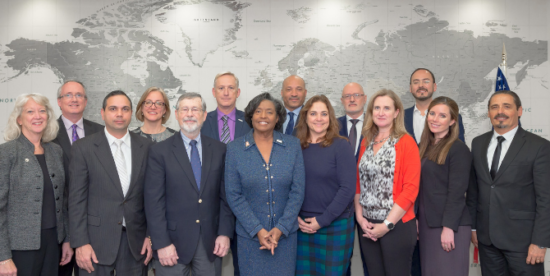 By Henry Collins (Ret.), Vice President, IVLP, Meridian International Center
By Henry Collins (Ret.), Vice President, IVLP, Meridian International Center
“Sure, we can do that!” That short, enthusiastic, but very welcome response from a Community-Based Member contact (formerly called Councils for International Visitors or CIVs) was my introduction to the Global Ties Network. It was 1991 and to this new program officer—beginning what would eventually become a 30-year career on the International Visitor Leadership Program (IVLP) team at Meridian International Center (known then as the Visitor Program Service of Meridian House International)—that brief response to my inquiry about possible inclusion in a project gave assurance that things would work out.
It took a while, though, to really understand the complexity of the Global Ties Network. The acronymic array that greeted me—CIVs, WACs (World Affairs Councils), IVCs (International Visitors Centers), CCDs (Centers for Citizen Diplomacy), and more—was daunting, but coming from an acronym-filled Army environment, I was pretty sure I’d eventually decode those myriad names for the hundred-or-so local nonprofit organizations who helped us implement the IVLP in cities and towns across the country.
Even calling them “CIVs” when most were not actually a Council for International Visitors soon seemed normal. This clearly wasn’t a franchise operation with a headquarters in Washington, DC and associated branch offices strategically placed around the country, but rather a somewhat organic grassroots network created by visionaries who saw the importance of opening their communities to international visitors, and were able to attract others to this work.
The variety of the organizations’ names, staffing, and origin stories all underlined the uniqueness of each community-based nonprofit, not to mention their geographic distribution, with some states having as many as six CBMs in one state or just one in many others. Maybe the proper metaphor for the Global Ties Network is a garden filled with plants of varying colors and sizes—an English garden, perhaps, a style originally created to contrast with the severe regimentation of the French approach and featuring a profusion of plants that seem appear more naturally, including the occasional “volunteer.”
To be sure, some of the CBM “plants” were propagated intentionally, such as when Lorrine Emery traveled from Dallas in the early 1960s to help civic and business leaders in Atlanta present a more welcoming face to the world. Others, such as the collection of rural communities in northern Illinois—Paris, Sterling, Freeport—that formed the International Thanksgiving Fellowship Program at around the same time, began by offering Thanksgiving hospitality to foreign students in the Chicago area, then to U.S. government-sponsored international visitors.* Regardless of how each community-based organization came to be, this dynamic and resourceful (and resource-full) Network has continued to grow and thrive.
As a program officer, I have been grateful for the excellent cooperation, useful advice, boundless imagination, and steadfast commitment given to the IVLP. While serving as a member of the Global Ties U.S. Board of Directors, I was able to see and appreciate the skills with which Global Ties U.S. staff and leadership cultivated the Network, administering the needed nutrients of training and funding [I could have said “fertilizer,” but that would have been one metaphor too mulch].

Henry Collins (fifth from left) with the Global Ties U.S. Board of Directors during a November 2018 board meeting. Credit: A.E. Landes Photography
The current challenge of COVID-19 is but the most recent to face the Network and follows previous public health challenges like SARS, Ebola, and Zika. In addition, constant “weeding” is required to deal with funding, volunteer recruitment, training and retention, and changes in the political winds. Fortunately, the Network is resilient and capable; it is ready to meet the next challenge. It is a remarkable garden indeed.
*More details in A Salute to Citizen Diplomacy, published by Global Ties U.S. (then known as the National Council for International Visitors) in 2000.
